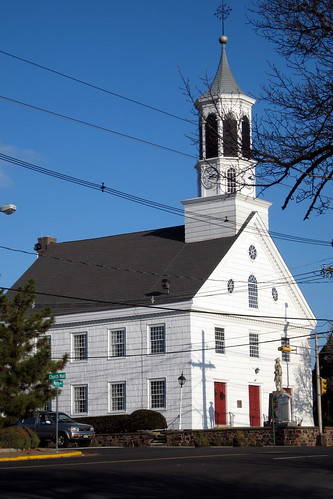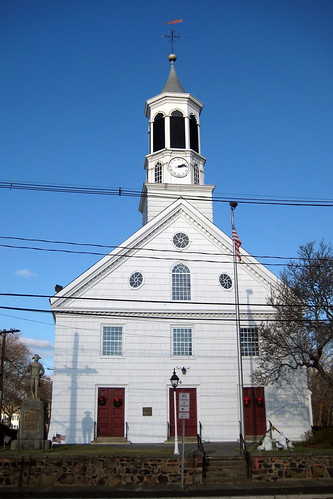NJ – Springfield: First Congregation of the Presbyterian Church at Springfield
Some cool dating services morristown nj images:
NJ – Springfield: First Congregation of the Presbyterian Church at Springfield

Image by wallyg
The First Presbyterian Church of Springfield dates to 1745. Three families who composed the total population of the crossroads settlement of Springfield joined with their neighbors from the outlying farmlands to form a Presbyterian congregation, under the Presbytery of New York. For sixteen years, the congregation gathered in a small log cabin at what is today Spring Street and Main Street in Millburn under pastor was Rev. Timothy Syms. In 1761, a second, larger sanctuary was built on the site of the present building.
In November of 1778, as the American Revolution drew to a climax, the congregation opened the sanctuary for use as a public storehouse, while worship services were moved to the garret of the parsonage. On June 23, 1780, the Battle of Springfield was fought to prevent the advancement of British and Hessian soldiers to Washington’s Headquarters in Morristown. Rev. James "Fighting Parson" Caldwell was serving as the Chaplain of Colonel Jonathan Dayton’s regiment of the Continental Army. As the Patriots ran out of wadding for their guns during the crucial battle, Rev. Caldwell rushed into the church, ripping pages from the hymnals written by Isaac Watts for use as wadding, shouting, "Give ‘em Watts, boys!" An original Watts hymnal is on display in the entrance of the sanctuary.
After burning the church to the ground, the British were forced to retreat to Staten Island, and fighting on New Jersey soil was ended. Today, the smallest state park in New Jersey, measuring only ten square feet, is located on the front lawn of the church. Here, a monument of the Revolutionary Soldier was commemorated in 1905. Following the destruction of the church, the congregation met in the parsonage barn, where Rev. Jacob Van Arsdale added more balconies to accommodate the growing congregation.
In 1791, the present building was constructed, using labor and materials from the congregation. While women prepared food for the volunteers in booths flanking the site, men brought their tools and the best timber their farms could furnish. Contributions were solicited from churches in the Presbytery of New York. In 1892, the clock tower was donated by a descendant of Rev. Van Arsdale.
In the 1980’s, a major restoration project was undertaken, as the church was outfitted with an aluminum replica of the original bell tower, foundation reinforcement, steel tie rods and posts to support the sanctuary, insulation, and hand-hewn cedar shake shingles, exactly like the originals.
New Jersey State Register (1990)
National Register #90000668 (1990)
NJ – Springfield: First Congregation of the Presbyterian Church at Springfield

Image by wallyg
The First Presbyterian Church of Springfield dates to 1745. Three families who composed the total population of the crossroads settlement of Springfield joined with their neighbors from the outlying farmlands to form a Presbyterian congregation, under the Presbytery of New York. For sixteen years, the congregation gathered in a small log cabin at what is today Spring Street and Main Street in Millburn under pastor was Rev. Timothy Syms. In 1761, a second, larger sanctuary was built on the site of the present building.
In November of 1778, as the American Revolution drew to a climax, the congregation opened the sanctuary for use as a public storehouse, while worship services were moved to the garret of the parsonage. On June 23, 1780, the Battle of Springfield was fought to prevent the advancement of British and Hessian soldiers to Washington’s Headquarters in Morristown. Rev. James "Fighting Parson" Caldwell was serving as the Chaplain of Colonel Jonathan Dayton’s regiment of the Continental Army. As the Patriots ran out of wadding for their guns during the crucial battle, Rev. Caldwell rushed into the church, ripping pages from the hymnals written by Isaac Watts for use as wadding, shouting, "Give ‘em Watts, boys!" An original Watts hymnal is on display in the entrance of the sanctuary.
After burning the church to the ground, the British were forced to retreat to Staten Island, and fighting on New Jersey soil was ended. Today, the smallest state park in New Jersey, measuring only ten square feet, is located on the front lawn of the church. Here, a monument of the Revolutionary Soldier was commemorated in 1905. Following the destruction of the church, the congregation met in the parsonage barn, where Rev. Jacob Van Arsdale added more balconies to accommodate the growing congregation.
In 1791, the present building was constructed, using labor and materials from the congregation. While women prepared food for the volunteers in booths flanking the site, men brought their tools and the best timber their farms could furnish. Contributions were solicited from churches in the Presbytery of New York. In 1892, the clock tower was donated by a descendant of Rev. Van Arsdale.
In the 1980’s, a major restoration project was undertaken, as the church was outfitted with an aluminum replica of the original bell tower, foundation reinforcement, steel tie rods and posts to support the sanctuary, insulation, and hand-hewn cedar shake shingles, exactly like the originals.
New Jersey State Register (1990)
National Register #90000668 (1990)
NJ – Springfield: First Congregation of the Presbyterian Church at Springfield

Image by wallyg
The First Presbyterian Church of Springfield dates to 1745. Three families who composed the total population of the crossroads settlement of Springfield joined with their neighbors from the outlying farmlands to form a Presbyterian congregation, under the Presbytery of New York. For sixteen years, the congregation gathered in a small log cabin at what is today Spring Street and Main Street in Millburn under pastor was Rev. Timothy Syms. In 1761, a second, larger sanctuary was built on the site of the present building.
In November of 1778, as the American Revolution drew to a climax, the congregation opened the sanctuary for use as a public storehouse, while worship services were moved to the garret of the parsonage. On June 23, 1780, the Battle of Springfield was fought to prevent the advancement of British and Hessian soldiers to Washington’s Headquarters in Morristown. Rev. James "Fighting Parson" Caldwell was serving as the Chaplain of Colonel Jonathan Dayton’s regiment of the Continental Army. As the Patriots ran out of wadding for their guns during the crucial battle, Rev. Caldwell rushed into the church, ripping pages from the hymnals written by Isaac Watts for use as wadding, shouting, "Give ‘em Watts, boys!" An original Watts hymnal is on display in the entrance of the sanctuary.
After burning the church to the ground, the British were forced to retreat to Staten Island, and fighting on New Jersey soil was ended. Today, the smallest state park in New Jersey, measuring only ten square feet, is located on the front lawn of the church. Here, a monument of the Revolutionary Soldier was commemorated in 1905. Following the destruction of the church, the congregation met in the parsonage barn, where Rev. Jacob Van Arsdale added more balconies to accommodate the growing congregation.
In 1791, the present building was constructed, using labor and materials from the congregation. While women prepared food for the volunteers in booths flanking the site, men brought their tools and the best timber their farms could furnish. Contributions were solicited from churches in the Presbytery of New York. In 1892, the clock tower was donated by a descendant of Rev. Van Arsdale.
In the 1980’s, a major restoration project was undertaken, as the church was outfitted with an aluminum replica of the original bell tower, foundation reinforcement, steel tie rods and posts to support the sanctuary, insulation, and hand-hewn cedar shake shingles, exactly like the originals.
New Jersey State Register (1990)
National Register #90000668 (1990)

Comments are closed.